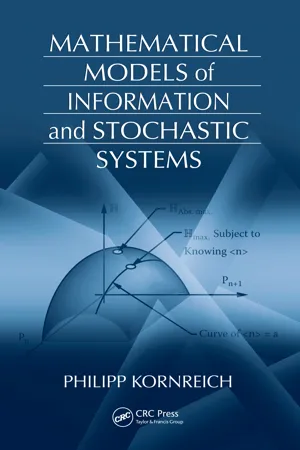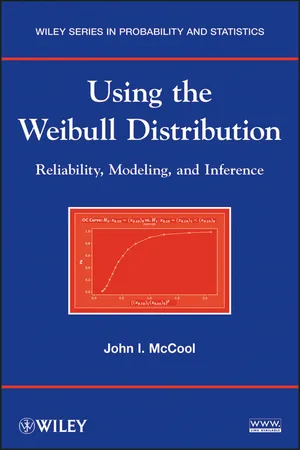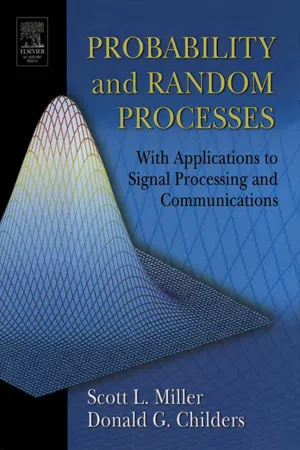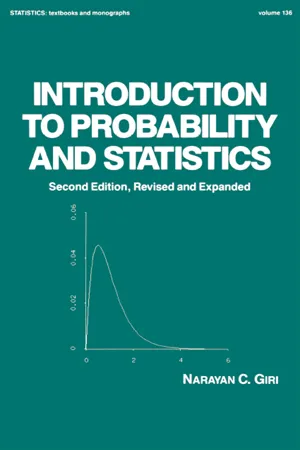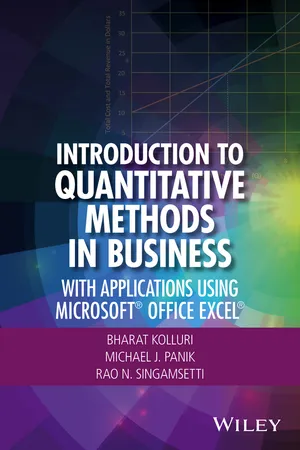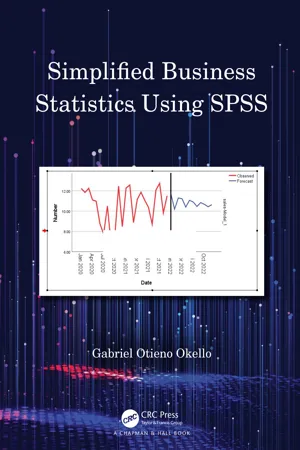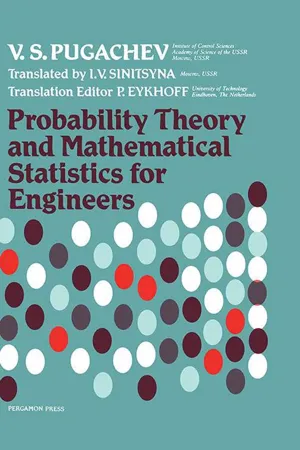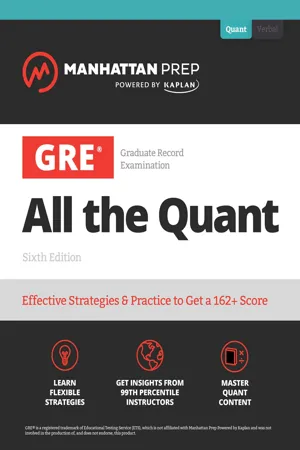Mathematics
Mutually Exclusive Probabilities
Mutually exclusive probabilities refer to events that cannot occur simultaneously. In other words, if one event happens, the other cannot. When calculating the probability of mutually exclusive events, the probabilities of each event are added together. For example, when rolling a standard six-sided die, the probabilities of rolling a 2 or a 4 are mutually exclusive.
Written by Perlego with AI-assistance
Related key terms
Related key terms
1 of 4
Related key terms
1 of 3
11 Key excerpts on "Mutually Exclusive Probabilities"
- Philipp Kornreich(Author)
- 2018(Publication Date)
- CRC Press(Publisher)
n has occurred or not. This has been discussed before; that is, the conditional probabilities are equal to the independent probabilities.
As has been shown before, for statistically independent events the joint probability is equal to the product of the individual independent probabilities.P(= P)A nB m(a n d PA n)(= Q)B m|A n(B m)(3.8) P(= P)A n∩B m(QA n)(B m)(3.9) Events An and Bm are not necessarily mutually exclusive. Obviously, events that are not statistically independent are statistically dependent events.Two events An and Ak are mutually exclusive if the occurrence of event An precludes the occurrence of event Ak , and vice versa. For example, if one rolls a 4 with a particular die one cannot simultaneously roll a 2 with the same die. Thus, the events of rolling a 4 and rolling a 2 with the same die are mutually exclusive. In this case, the joint probability for the two such events occurring is equal to zero.
Another example is the events of a coin landing on its head or tail. These two events are also mutually exclusive. If the coin landed on its head, it cannot also land on its tail.P(= 0)A n∩A K(3.10) Without confusing the reader, the concept of exclusive events is only true in a physical world that can be described by classical models. For example a coin cannot simultaneously land on its tail and head side. For physical systems described by quantum mechanics, this is not true. For example, in a quantum mechanical description an electron has a spin angular momentum. The classical equivalent would be the electron spinning about its own axis. However, in the quantum mechanical description, it can only spin with a single magnitude of the angular momentum, or angular velocity. It can spin either clockwise or counterclockwise with an angular momentum equal to Plank’s constant divided by 2π. Unlike a classical particle, an electron can have, say, a probability of 0.2 of spinning clockwise and a probability of 0.8 of spinning counterclockwise at the same time. This is Schrödinger’s cat paradox, which will be discussed in a later section.- eBook - ePub
Using the Weibull Distribution
Reliability, Modeling, and Inference
- John I. McCool(Author)
- 2012(Publication Date)
- Wiley(Publisher)
Events and are subsets of the sample space. For example, in the die tossing experiment, if we agree that an event named A occurs when the number on the upward face of a tossed die is a 1 or a 6, then the corresponding subset is A = {1, 6}. The individual members of the sample space are known as elementary events. If the event B is defined by the phrase “an even number is tossed,” then the set B is {2, 4, 6}. In the card example, an event C defined by “card suit is red” would define the subset C = {diamond, heart}. Notationally, the probability that some event “E” occurs is denoted P(E). Since the sample space comprises all of the possible elementary outcomes, one must have P(Ω) = 1.0.1.2 MUTUALLY EXCLUSIVE EVENTS
Two events are mutually exclusive if they do not have any elementary events in common. For example, in the die tossing case, the events A = {1, 2} and B = {3, 4} are mutually exclusive. If the event A occurred, it implies that the event B did not. On the other hand, the same event A and the event C = {2, 3, 4} are not mutually exclusive since, if the upward face turned out to be a 2, both A and C will have occurred. The elementary event “2” belongs to the intersection of sets A and C. The set formed by the intersection of sets A and C is written as A ∩C . The probability that the outcome will be a member of sets A and C is written as P (A ∩C ).When events are mutually exclusive, the probabilities associated with the events are additive. One can then claim that the probability of the mutually exclusive sets A and B is the sum of P (A ) and P (B ).In the notation of set theory, the set that contains the elements of both A and B is called the union of A and B and designated A ∪ B - eBook - ePub
Probability and Random Processes
With Applications to Signal Processing and Communications
- Scott Miller, Donald Childers(Authors)
- 2004(Publication Date)
- Academic Press(Publisher)
B can never be both independent and mutually exclusive. Thus, mutually exclusive events are necessarily statistically dependent.A few generalizations of this basic idea of independence are in order. First, what does it mean for a set of three events to be independent? The following definition clarifies this and then we generalize the definition to any number of events.DEFINITION 2.7: The events A , B , and C are mutually independent if each pair of events is independent; that is,(2.24a)(2.24b)(2.24c)and in addition,(2.24d)DEFINITION 2.8: The events A 1 , A 2 , …,Anare independent if any subset of k < n of these events are independent, and in addition(2.25)There are basically two ways in which we can use this idea of independence. As shown in Example 2.15 , we can compute joint or conditional probabilities and apply one of the definitions as a test for independence. Alternatively, we can assume independence and use the definitions to compute joint or conditional probabilities that otherwise may be difficult to find. This latter approach is used extensively in engineering applications. For example, certain types of noise signals can be modeled in this way. Suppose we have some time waveform X (t ) which represents a noisy signal that we wish to sample at various points in time, t 1 , t 2 ,…, t n . Perhaps we are interested in the probabilities that these samples might exceed some threshold, so we define the eventsAi= Pr(X (ti) > T ), i = 1, 2, …, n . How might we calculate the joint probability Pr(A 1 , A 2 , …, A n )? In some cases, we have every reason to believe that the value of the noise at one point in time does not affect the value of the noise at another point in time. Hence, we assume that these events are independent and write Pr(A 1 , A 2 , …, A n ) = Pr(A 1 )Pr(A 2 ) … Pr(A n - eBook - ePub
- Giri(Author)
- 2019(Publication Date)
- CRC Press(Publisher)
Substituting these in the expression above, the theorem follows. Q.E.D.Theorem 2.1.3.4 is called the theorem on multiplication of probabilities.Our aim was to develop a calculus of probabilities. The theorem on addition of probabilities (Theorem 2.1.3.1) and the theorem on multiplication of probabilities (Theorem 2.1.3.4) are the two important components of this calculus.We have seen that the theorem of addition of probabilities holds only for mutually exclusive events, and that of multiplication of-probabilities holds only for independent events. Mutual exclusiveness and independence of events are thus two essential concepts we need for developing the calculus of probability. Of these, the physical concept of mutual exclusiveness of events is quite clear and follows immediately from definition. Two events A and B are mutually exclusive if the happening of one of them precludes the happening of the other. Physically, this means that the subsets SA and SB of the sample space, defining the events A and B, respectively, do not have any point in common. Such a simple set-theoretical exposition does not seem to be possible for independent events, and this obscures a lucid physical interpretation of independence of events. All that can be said in the way of offering a physical interpretation of independence of events is that a set of events are independent if the probability of any one of them is not affected by supplementary knowledge concerning the materialization of any of the remaining events. But this amounts to giving a physical description of the fact that the conditional probabilities of any of the events given one or more of the remaining events is the same as its unconditional probability.Pairwise Independence and IndependenceWe have seen that if two events A and B - eBook - ePub
Introduction to Quantitative Methods in Business
With Applications Using Microsoft Office Excel
- Bharat Kolluri, Michael J. Panik, Rao N. Singamsetti(Authors)
- 2016(Publication Date)
- Wiley(Publisher)
mutually exclusive if the occurrence of A precludes the occurrence of B. For example, heads and tails are mutually exclusive events when we toss a coin once. Likewise, odd scores and even scores are mutually exclusive when rolling a die once.Note that two complementary events are always mutually exclusive, but the converse is not always true. For example, in a deck of 52 cards, the clubs and spades are always mutually exclusive, but they are not complementary, since they do not collectively exhaust the whole deck of 52 cards.5.5 Probability Laws
5.5.1 General Rule of Addition
The general addition rule is useful in applications when we are interested in finding the likelihood or the chance of occurrence of at least one of two events. Here the phrases “at least one of the two” or “one of the two” refer to the “union” of both the events.If A and B are two sets of events, generally,where P(A) and P(B) are known (simple) probabilities. More particularly, these are also known as marginal probabilities because each one considers exclusively an individual set. or are known as joint probabilities, which are identical. These are also written as or without the symbol. They represent the probability of the common part of sets A and B.Here, when we add P(A) and P(B), the common part of A and B is counted twice, once as part of A and a second time as part of B. So, the common part is subtracted once to avoid double counting.Example 5.7
In an undergraduate business program at a certain college, there are a total of 200 sophomore students. From this group, a total of 120 take the business statistics course, 90 take the first accounting course, and 60 students take both courses. Find the probability that a randomly selected student takes at least one of the two courses. Interpret the result.SOLUTION: - eBook - ePub
- Gabriel Otieno Okello(Author)
- 2022(Publication Date)
- Chapman and Hall/CRC(Publisher)
Part II Probability ConceptsPassage contains an image
5 Introduction to Probability
DOI: 10.1201/9781003292654-75.1 Basic Probability Concepts
Probability is a numerical measure of likelihood (certainty or uncertainty) that an event will occur. The value of probability lies between 0 (0%) and 1 (100%).Experiment is a process that generates well-defined outcomes. Experiment is an act that can be repeated under given conditions. For example, tossing a coin will generate outcomes of either having head or tail, sitting for an exam, attending a job interview, etc.A sample space for an experiment is the set of all experimental outcomes. By specifying all possible experimental outcomes, we identify the sample space for an experiment. For example: in the experiment of tossing a coin, the sample space isS =H e a d , T a i lAn Events is a collection of sample points. An event is a possible outcome of an experiment or a result of atrial or an observation.Types of EventsThe following are some of the types of events:- Elementary Events: events that cannot be decomposed or broken down into other events They are events which contains only single outcome in the sample space. For example, tossing a six-sided dice will give elementary events which are 1,2,3,4,5,6.
- Mutually Exclusive Events: these are two or more events that cannot happen at the same time”. For example, when one tosses a coin you can only get a head or a tail and not both at the same time.
- Not Mutually Exclusive Events: These are two or more events that can happen at the same time. For example, an individual can be reading and listening to music at the same time.
- Independent Events: two or more events are independent events if the occurrence or nonoccurrence of one of the events does not affect the occurrence or nonoccurrence of the other event(s).
- Collectively Exhaustive Events:
- Amit Kumar Gorai, Snehamoy Chatterjee(Authors)
- 2022(Publication Date)
- CRC Press(Publisher)
events (A ∩ A 1), (A ∩ A 2), …, (A ∩ A n) are mutually exclusive (if one occurs, then none of the others can occur). Thus, from the law of probability for mutually exclusive events, we. have P (A) = P (A ∩ A 1) + P (A ∩ A 2) + … + P (A ∩ A n) ⇒ P (A) = P (A ∩ A 1) + P (A ∩ A 2) + … + P (A ∩ A n) ⇒ P (A) = P (A | A 1) * P (A 1) + P[--=PLGO-S. EPARATOR=--](A | A 2) * P (A 2) + … + P (A | A n) * P (A n) ⇒ P (A) = ∑ i = 1 n P (A | A i) * P (A i) 2.8 Bayes’ rule The most useful property of conditional probability is Bayes’ rule. If the value of conditional probability P (B | A) is known, the value of conditional probability P (A | B) can be easily determined using Bayes’ rule. The theorem can be derived as follows: The conditional probability, P (A | B) for two events, A and B can be presented as: P (A | B) = P (A ∩ B) P (B), where P (B) ≠ 0 Similarly, the conditional probability P (B | A) for two events, A and B can be written as: P (B | A) = P (B ∩ A) P (A), where P (A) ≠ 0 Since the joint probabilities of two events are equal, we. have P (B ∩ A) = P (A ∩ B) Therefore, P (A ∩ B) = P (A | B) P (B) = P (B | A) P (A) ⇒ P (A | B) = P (B | A) P (A) P (B), P (B) ≠ 0 [ Bayes' Rule ] (2.19) In order to. find P (B) in Bayes’ formula, we need to use the law of total probability, as demonstrated in Eq. 2.7. The Bayes’ rule can be reduced to P (A k | B) = P (B | A k) P (A k) ∑ i P (B | A i) P (A i) (2.20) where, A 1, A 2,..., A n form a partition of the sample space. Example 2.16: Iron ore samples are collected from three mines, A, B, and C. In mine A, 60% of samples have grade values greater than cut-off grade, in mine B, 50% of the samples have grades greater than cut-off grade, and in mine C, 40% of the samples have grades greater than the cut-off grade. Of the total sample from three mines, 40% are from mine A, 25% from mine B, and 35% from mine C- V. S. Pugachev(Author)
- 2014(Publication Date)
- Pergamon(Publisher)
k = Ω.It follows from the axiom of probability addition that if the events A 1 ,…, A n are exclusive and form a complete set then the sum of their probabilities is unity:(1.14)= 1.∑i = 1nP(A i)(1.14)Complementary events are exclusive and form a complete set. Therefore it follows from (1.14) that the sum of the probabilities of complementary events is unity:P(1.15)( A )+ P(= 1.A ¯)(1.15)This formula is very important for practice. In many problems it is difficult to calculate the probability of an event while the probability of the complementary event may be easily calculated. In such cases formula (1.15) is useful.Passage contains an image
The property of frequency multiplication gives a natural way for defining a conditional probability.1.6 Conditional probabilities
1.6.1 Conditional probability
The ratio of the probability of the intersection of events A and B to the probability of the event B , if P (B ) ≠ 0, is called the conditional probability of the event A relative to the event B .P ( A(1.16)|=B ).P(A B)P( B )(1.16)For such a definition of conditional probability the theorem of frequency multiplication can evidently be extended to the probabilities:P(1.17)(= PA B)( A )P ( B|= PA )( B )P ( A|B ) .(1.17)Thus the probability of joint appearance of two events is equal to the probability of one of them multiplied by the conditional probability of the other .It follows from the definition (1.16) that the conditional probabilities of various events relative to the same event B, P (B- eBook - ePub
- Yongmiao Hong(Author)
- 2017(Publication Date)
- WSPC(Publisher)
Figure 2.1(a) .Definition 2.5. [Exclusiveness]: If A and B have no common basic outcomes, they are called mutually exclusive and their intersection is empty set ∅, i.e., A∩B = ∅, where ∅ denotes an empty set that contains nothing. By convention, an empty set ∅ is a subset of any set.Two exclusive events A and B can be represented by the Venn diagram in Figure 2.1(b) .Mutually exclusive events are also called disjoint because they do not overlap when represented in the Venn diagram. By definition, any mutually exclusive events cannot occur simultaneously. As an example, any pair of the basic outcomes in sample space S are mutually exclusive, because when a random experiment is performed, one and only one basic outcome will occur.Definition 2.6. [Union]: The union of A and B, A ∪ B, is the set of all basic outcomes in S that belong to either A or B. The union of A and B occurs if and only if either A or B (or both) occurs.The union of A and B is also called the logical sum. It can be represented by the Venn diagram in Figure 2.1(c) .Definition 2.7. [Collective Exhaustiveness]: Suppose A1 , A2 , · · ·, An are n events in the sample space S, where n is any positive integer. If then these n events are said to be collectively exhaustive.Definition 2.8. [Complement]: The complement of A is the set of basic outcomes of a random experiment belonging to S but not to A, denoted as Ac .The complement of event A is also called the negation of A. It can be represented by the Venn diagram in Figure 2.1(d) .Obviously, any event A and its complement Ac are mutually exclusive and collectively exhaustive. That is, A ∩ Ac = ∅ and A ∪ Ac = S.Figure 2.1(a): A ∩ BFigure 2.1(b): Two exclusive eventsFigure 2.1(c): A ∪ BFigure 2.1(d): AcFigure 2.1(e): A − BDefinition 2.9. [Difference]: - eBook - ePub
- Alandra Kahl(Author)
- 2008(Publication Date)
- Bentham Science Publishers(Publisher)
28 ].Example 2
Only one die is rolled. Assume the die is balanced. Calculate the chances that the rolled number is both even and bigger than two.Assume the dice has been “loaded” such that P(1)=1/12, P(6)=3/12 and the four remaining possibilities are all equally probable. Calculate the chances that the rolled number is both even and bigger than two [28 ].Solution
The sample space in both instances is S={1,2,3,4,5,6}, and the event in question is the intersection E∩T={4,6} from the preceding example.- Because all possibilities are equally probable because the die is fair, we can get P(E∩T)=2∕6 by counting.
- The information we have so far on the odds of the six scenarios is [28 ]
Outcome 1 2 3 4 5 6 Probability 1/12 p p p p 3/12 Since P (1) + P (6) = 4 / 12 = 1/3 and the probabilities of all six outcomes add up to 1,P(2)+ P(3) + P(4) + P(5) = 1-1/3=2/3Thus 4p = 2 /3, so p=1/6. In particular P (4) = 1/6. ThereforeP(E∩T)=P(4)+P(6)= 1/6 +3/12 =5/12Definition
If events A and B have no components in common, they are mutually exclusive.The fact that A and B have no outcomes in common indicates that both A and B cannot occur on a single trial of the random experiment. As a result, the following rule emerges [28 ].Probability Rule for Mutually Exclusive Events
Events A and B are mutually exclusive if and only ifP(A∩B)=0 [28 ] A and Ac are mutually exclusive in every case, while A and B might be mutually exclusive without complements.Example
Find three options for event A in the experiment of rolling a single die such that events A and E: “the number rolled is even” are mutually incompatible.Solution
Because E={2,4,6} and we don't want A to have many components in common with E, any event with an odd number will suffice. {1,3,5} (the complement Ec the odds), {1,3} and {5} are the three options [28 - eBook - ePub
GRE All the Quant
Effective Strategies & Practice from 99th Percentile Instructors
- (Author)
- 2023(Publication Date)
- Manhattan Prep(Publisher)
add them together. This is the essence of what makes “or” questions different than “and” questions. Multiply for “and.” Add for “or.”To find the probabilities for an “or” problem, you must first understand the concept of mutual exclusivity. Two events are said to be mutually exclusive if they cannot both occur at the same time. For example, when you roll a single die one time, you will either get a 4 or not get a 4. It’s not possible to roll both a 4 and another number at the same time.Because it’s impossible to roll both a 4 and a 5 on a single roll, these are mutually exclusive outcomes.The probability that the die will land on 4 is . The probability that the die will land on 5 is also . To find the probability that the die will land on either 4 or 5, add the individual probabilities: .Note that the probability of having the die come up either 4 or 5 is greater than the probability of a 4 by itself or of a 5 by itself . When success is defined in a less constrained way (e.g., “I can win either this way or that way”), then the probability of success will be greater. When you add together two fractions, you get a greater result, which means a greater probability.Remember this question? If two fair dice are rolled (with faces 1, 2, 3, 4, 5, and 6), what is the probability that at least one 3 will be rolled? There are three possible successful outcomes: Just the first die could be a 3, just the second die could be a 3, or both could be 3.When you roll one die, you have a one-in-six chance of rolling a 3, so the probability of rolling a 3 is . If you don’t roll a 3, then you will roll a 1, 2, 4, 5, or 6. The probability of not rolling a 3 is .Those two scenarios—rolling a 3 or not rolling a 3—constitute all of the possible outcomes when you roll this one die, so those two probabilities add up to 100%, or 1. For any scenario, it’s always the case that the probabilities of all
Index pages curate the most relevant extracts from our library of academic textbooks. They’ve been created using an in-house natural language model (NLM), each adding context and meaning to key research topics.
Explore more topic indexes
Explore more topic indexes
1 of 6
Explore more topic indexes
1 of 4
